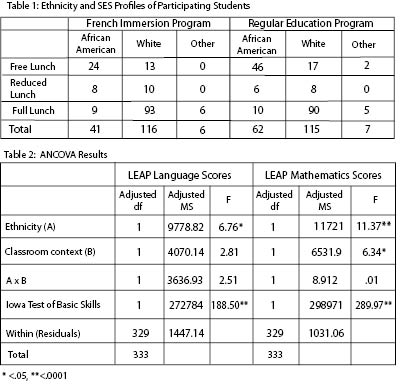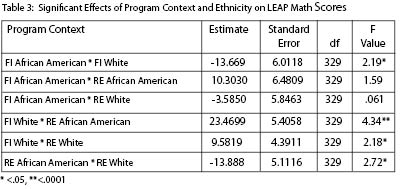Comparison Contexts:
African-American Students, Immersion
and Achievement
The ACIE Newsletter, May 2005, Vol. 8, No. 3
by Michelle Haj-Broussard, Assistant Professor of Teacher Education, McNeese State University, Lake Charles, LA
 |
In dual language education much research has focused on the acquisition of academic content or the acquisition of language. However, as Valdes (1997) argued, dual language education does not occur in a sociocultural vacuum. Rather, it reflects the contexts and power structures within which it exists. In the U.S. dual language education confronts the national dilemma of a majority/minority student achievement gap. In the South, this dilemma is known as the Black/White Achievement Gap. This study examines the Black/White Achievement Gap in a very specific sociocultural context—Southwestern Louisiana—where many African-American students also have francophone cultural heritage.
The Black/White Achievement Gap is an issue that cannot be
overlooked. Hedges and Nowell (1998) determined that there
is still a significant gap in Black/White achievement, especially
in the top 10% of achievement test score distribution. More
importantly, these authors note that this distribution has
not changed significantly since 1965. If the achievement gap
cannot be closed at the elementary and secondary levels, the
racially unequal social stratification is likely to become
even more pronounced. In this age of high-stakes testing,
a disproportionate number of African-American students risk
being retained or tracked into lower-level classes, thereby
becoming ineligible for college admission.
Having taught French immersion (FI) for nine years in Title
I schools with 40-99% African-American students, I had always
been impressed with my students’ academic progress in
the program. Despite, this teacher’s hunch, the true
impetus of this research was the threatened closing of all
four Louisiana FI programs in schools with over 90% African-American
students.1 This situation came about even though previous
research in the U.S. had indicated certain benefits for African-American
students in the language immersion context. For example, early
studies of partial immersion students in a large urban school
district had shown language benefits but relatively few academic
benefits in primary school (Holobow, Genesee, Lambert, Gastright,
& Met, 1987; Holobow, Genesee & Lambert, 1991). More
recently, Caldas & Boudreaux (1999) found general academic
benefits for African-American FI students in late elementary
immersion classrooms. Apart from these studies, however, little
research has been conducted on the effects French immersion
has on the academic achievement of African-American students.
This study examined differences in minority/majority student
achievement in both the French immersion (FI) and the regular
education (RE) classroom contexts. In addition, it explored
how African-American students, their peers and their teachers
(1) perceive themselves, (2) perceive others, and (3) interact
within each school setting. This article reports on the quantitative
findings alone.
Research Questions
Phase I of the study includes a quantitative analysis of covariance
comparing immersion and non-immersion fourth grade students’
LEAP (Louisiana Educational Academic Performance) scores.
Using the fourth graders’ third grade Iowa Test of Basic
skills (ITBS) scores as a control, this phase investigated:
1. Whether there were differences in academic achievement
between African-American students and White students,
2. Whether there were differences in academic achievement
between French immersion students and regular education students
and
3. Whether there was any interaction effect between these
student groups.
Participant Information
A total of 347 grade four students participated in the quantitative
phase of the study. Of these students 163 were in the FI program
and 184 were in the RE program. Table 1 summarizes information
on the socioeconomic status (SES) and the ethnicity of the
participants. While the number of students who paid full lunch
prices and the number of White students were equivalent in
both fourth grade classrooms, the RE setting had nearly thirty
more students on free lunch. More White students in both program
contexts were in the higher SES category and paid full price
for their lunches while the majority of African-American students
in both contexts were in the lower SES category (either free
or reduced lunch programs).
In terms of ethnicity, there were over twenty more African-American
students in the RE classes than in the FI classes. This was
after one FI class was excluded from the study because it
had no African-American students despite the school having
a 40% African-American student population. Students from other
ethnic backgrounds were balanced across programs.

Quantitative Results
Initial findings of the quantitative data analysis revealed
(1) that White students scored significantly higher that African-American
students [see ethnicity (A)], and (2) that FI students scored
significantly higher than RE students [see classroom context
(B)]. The combined effect of ethnicity and program context
were not shown to significantly impact test performance (Table
2).
A closer examination of the subgroups found that there was
no significant difference in test scores between African-American
students regardless of program context (see Table 3 on page
10). This supports Holobow et al. (1987; 1991) earlier findings
that African-Americans in dual language programs do as well
as African-Americans in regular education. However, it must
be noted that in the area of mathematics there was also no
significant difference between the math scores of African-American
FI students and the White students in RE (although there was
a significant difference between African-American RE students
and White RE students). This may indicate a bridging of the
achievement gap, but it does not fully support Caldas and
Boudreaux (1999) who found that the achievement gap decreased
or disappeared among immersion students from diverse racial
backgrounds. This bridging of the achievement gap was found
despite the fact that one third of the African-American students
in French immersion were in a program which the qualitative
phase found to be a less than ideal immersion setting.
Suggestions for Future Research
Because of the use of the third grade Iowa Test of Basic Skills
(ITBS) scores as a covariate, the four years of immersion
schooling prior to taking the ITBS were not taken into account.
Considering that the FI students obtained ITBS scores were
higher than the RE student scores, a longitudinal study of
immersion which could account for those initial four years
would be useful. Because of the pivotal role of parents who
choose to place their children in immersion, the effect of
this parental involvement on the children’s academic
achievement also needs to be examined. The lack or absence
of African-American students in immersion programs situated
in schools with large African-American populations underscores
the need to study which students enter or leave immersion
and why. Finally, a replication of this study in a geographical
area where French is not a heritage language for the African-American
students could increase the generalizability of the findings
in this study and allow for conclusions regarding the effect
that learning a heritage language versus simply learning a
second language has on students.
Conclusion
Immersion is not a panacea for ameliorating African-American
students’ education. However, in terms of the educational
equity for African-American students, this study lends support
to earlier findings and shows that African-American students’
are as academically successful in these programs as African-American
students in non-immersion programs. Furthermore, the positive
collective self-esteem (one of the findings from the qualitative
phase of this study), extensive language skills and high LEAP
scores of the FI students in well-implemented programs indicate
that immersion is a beneficial environment for African-American
and White students.
Footnotes
1 Two of the schools were closed after this study as part
of school districts’ desegregation plans.
